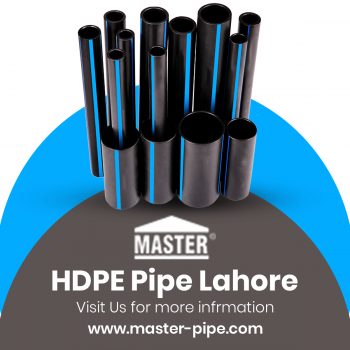Master Pipe Industries (Pvt) Limited has joined the uPVC Pipes, PPRC Pipes & Fittings manufacturing sector intending to support the country by providing quality goods in Mega Projects as well as small consumers. The firm had set up its factory in Pakistan’s great Textile Town, called Faisalabad, renowned for its Textile Goods.
Our firm also produces PVC electrical conduits for electrical wiring systems, dirt, water, vent pipes, and fittings for residential houses, apartments, and multi-story buildings, above and below ground. Deep Well Pumps, Pipe Wells, Sanitary Plumbing, Drainage, Sewerage, Forestry, Horticulture, Green House Irrigations, Chilled Water for Irrigation, and Air Conditioning are used in hand driven master pipes.
PVC Over the last 40 years, many of the components like steel, iron, and concrete have been eliminated as they appear to destroy. Most of the issues had been solved with the use of PVC. Because of their lightweight, thermoplastics, in general, are easier to handle and transport, plus they have excellent properties. The consequences of the atmosphere are minimal; they are immune to growing salts and chemicals. PVC has proven to be, in general, one of the most flexible and inexpensive thermoplastics.
HDPE pipe Lahore is a type of flexible plastic pipe that is used for the transport of fluid and gas and is often used to repair aged concrete or steel mains. Built from HDPE (high-density polyethylene) thermoplastic, its high impermeability level and tight molecular bond render it ideal for high-pressure pipelines. HDPE pipe is used worldwide for applications such as water, gas, sewer, slurry transmission lines, rural irrigation, fire supply lines, electrical and communications pipes, and stormwater and drainage pipes.
The HDPE pipe can be connected by welding the tail, electrofusion welding, welding the plug, or welding the extrusion. During the connecting cycle, these joints heat the pipe, forming an utterly homogenous joint so that the weld becomes as reliable or robust as the original piping on either side of the weld. There is no need to use rubber seals or joining chemicals as it is used to connect the PVC pipe, which causes environmental health problems and increases the likelihood of fault over time. PE is less likely to have root intrusion problems and provides pipeline integrity, even when installed in unstable soils.
The HDPE pipe or pprc pipe is very robust and versatile and can be twenty-five times the average width of the tube on site-for SDR11 and SDR17 pipes, at or below 20 ° C ambient temperature. It offers significant cost savings as contrasted with other pipe structures, some of which include fixed fittings, braces, or thrust blocks for even small lateral adjustments. Because of the HDPE pipe’s high impact resistance and flexibility, it is well suited for installation in productive soils, including in areas prone to earthquakes. Because of its smooth bore and end to end joining processes, the HDPE pipe has very high flow power.
HDPE resin is heated and extruded through a die to create pipe lengths that define the pipeline diameter. The pipe’s wall thickness is calculated by a mix of die dimension, screw speed, and haul-off tractor velocity. Polyethylene pipe usually is black due to the addition of 3-5 percent of black carbon to the clear polyethylene. The addition of black carbon creates a product that is UV resistant. Other colours, but less common, are available. Colored or stripped HDPE pipe is usually 90-95 percent black material, with only 5 percent externally colored skin or stripe.
